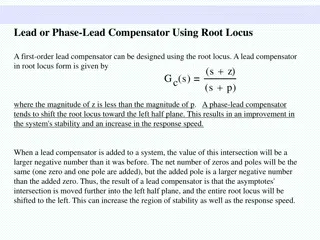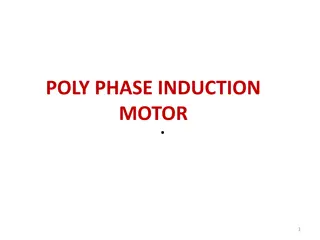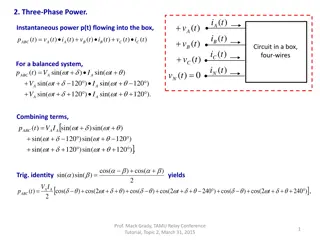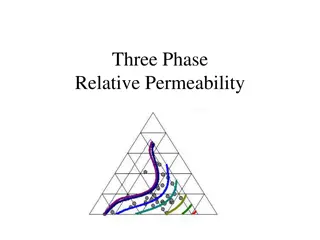
Stability of Fixed Points in Classical Mechanics and Electromagnetism
Explore the concept of fixed points in phase-space, their stability, and linearization for stability analysis in classical mechanics and electromagnetism. Learn how to identify stable and unstable fixed points using vector diagrams and eigenvalues. Gain insights into the motion near fixed points and the significance of eigenvectors in stability analysis.
Download Presentation

Please find below an Image/Link to download the presentation.
The content on the website is provided AS IS for your information and personal use only. It may not be sold, licensed, or shared on other websites without obtaining consent from the author. If you encounter any issues during the download, it is possible that the publisher has removed the file from their server.
You are allowed to download the files provided on this website for personal or commercial use, subject to the condition that they are used lawfully. All files are the property of their respective owners.
The content on the website is provided AS IS for your information and personal use only. It may not be sold, licensed, or shared on other websites without obtaining consent from the author.
E N D
Presentation Transcript
1 1 Topics in Phase-Space Jeffrey Eldred Classical Mechanics and Electromagnetism June 2018 USPAS at MSU
2 2 Fixed Points 2 3/18/2025 Classical Mechanics and Electromagnetism | June 2018 USPAS at MSU
3 Phase-space Vector Diagram For a coupled pair of first-order time-independent differential equations, we can create a 2D vector diagram of the phase-space. The fixed points, or equilibrium points, are where the derivatives of the coordinates are zero. 3 3/18/2025 Classical Mechanics and Electromagnetism | June 2018 USPAS at MSU
4 Stable & Unstable Fixed Points For a stable fixed point, the motion near the fixed point is cyclic and bounded. For an unstable fixed point, the motion diverges. 4 3/18/2025 Classical Mechanics and Electromagnetism | June 2018 USPAS at MSU
5 Other Types of Fixed Points with Damping/Excitation 5 3/18/2025 Classical Mechanics and Electromagnetism | June 2018 USPAS at MSU
6 Linearization for Stability of a Fixed Point We can determine the stability of a fixed point by studying the motion of trajectories near the fixed point. 6 3/18/2025 Classical Mechanics and Electromagnetism | June 2018 USPAS at MSU
7 Linearization for Stability of a Fixed Point (cont.) The deviation from the fixed point can be written as a linear combination of the eigenvectors for A. The instantaneous trajectory can be solved for an eigenvector: The exponentiated matrix exp(A) is called the local Jacobian matrix. The eigenvalues are called local Lyapunov coefficients. The fixed point is unstable if and only if the real part of any of its eigenvalues is positive 7 3/18/2025 Classical Mechanics and Electromagnetism | June 2018 USPAS at MSU
8 Eigenvalues and Eigenvectors: Reminder The eigenvalues and eigenvectors v of a matrix M fulfill: The eigenvalues are given by the n solutions to the equation: The eigenvector vi for the ith eigenvalue i is given by solving: Usually, the eigenvectors are then normalized by: If there are n distinct eigenvalues there will be n orthogonal eigenvectors, but this is not necessarily guaranteed. 8 3/18/2025 Classical Mechanics and Electromagnetism | June 2018 USPAS at MSU
9 Non-superposition of Fixed Points If I have separatrices and fixed points for system H1 and if I have separatrices and fixed points for system H2, what do I know about the separatrices and fixed points for H= H1 + H2? 9 3/18/2025 Classical Mechanics and Electromagnetism | June 2018 USPAS at MSU
10 10 Equipotential Curves 10 3/18/2025 Classical Mechanics and Electromagnetism | June 2018 USPAS at MSU
11 Time as degree-of-freedom If the Hamiltonian is not time-independent, we can find a time- independent Hamiltonian by defining a new spatial component Example: Driven Harmonic Oscillator As a time-dependent system, As a time-independent system, 11 3/18/2025 Classical Mechanics and Electromagnetism | June 2018 USPAS at MSU
12 Equipotential Curves Recall that if a Hamiltonian is time-independent, than the Hamiltonian is conserved. We can use the value of the Hamiltonian to specify a particular particle trajectory. Particle trajectories do not cross. For a fixed value of the Hamiltonian, we can write one coordinate in terms of the other along that trajectory. 12 3/18/2025 Classical Mechanics and Electromagnetism | June 2018 USPAS at MSU
13 Equipotential Curves (cont.) Example: Synchrotron Motion / Pendulum Separatrix: 13 3/18/2025 Classical Mechanics and Electromagnetism | June 2018 USPAS at MSU
14 Higher Dimensional Equipotential In the higher dimensional space, particle trajectories still do not cross and we can still find equipotential subspaces for a fixed value of the Hamiltonian. 14 3/18/2025 Classical Mechanics and Electromagnetism | June 2018 USPAS at MSU






















